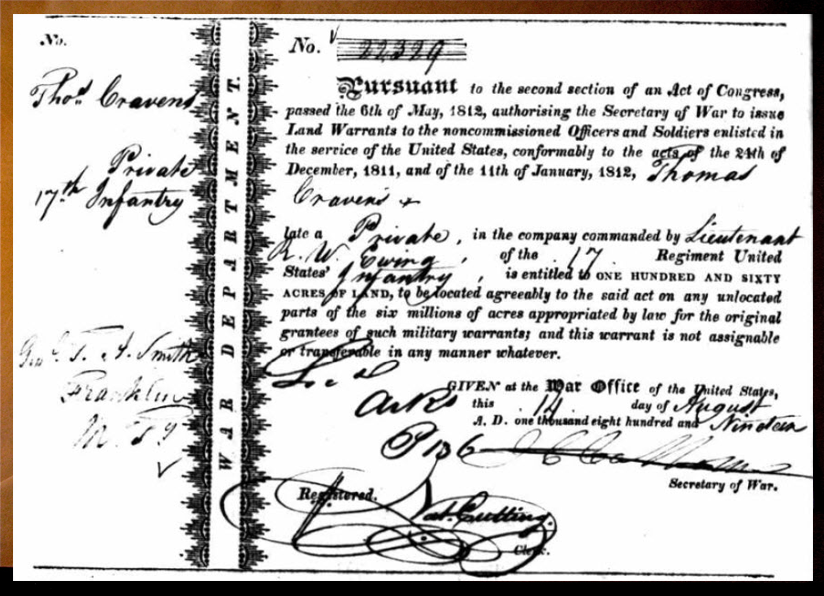11 February 2014
The Problem:
A neighbor has asked you for help, knowing how experienced you are in historical research. He grew up in a nineteenth-century Kentucky farm house that supposedly was built by man named Thomas Cravens. Online, he stumbled upon today's document. Being curious about the history of his childhood home, he's wondering if this is the same Thomas Cravens.
You've given him all the appropriate cautions, starting with: " 'Name's the same' doesn't mean the person is." You've asked him where online he found this but, of course, he doesn't know. What he is sure of is that you can find out something about this Thomas Cravens.
Your Challenge:
- The document needs to be analyzed.
- You need a short work plan of first steps to pursue on the basis of the information in this document.
Are you game? *

* If you need a model, you might check the comments by Yvette Hoitink on our last Document Day, 14 January 2013, when we analyzed a church register entry.
Document Analysis
Patti the Brave ventured in where others fear to tread—and she did a great job of both the analysis and the work plan. There remains just one critical element not mentioned in her analysis. Most likely she included it in her first draft but it fell by the wayside after that cybergremlin ate her first post amid the "save" command.
What about that notation in the bottom left corner? It's barely there, but it's still readable: Genl T. A. Smith, Franklin, M. Ty." Why was General Smith involved? That notation is immensely important to the outcome of the research project. It also inserts a big Whoa! into our analyses of most War of 1812 bounty land warrants and our tendency to accept, as gospel, the wording of legal acts such as the one that Patti appropriately invoked.
The circumstances—and the evidence that backs up this assertion EE has just made—are much too complicated to deal with in a "comment" on a blog. We'll make it the subject of an upcoming QuickLesson.
My comments on the Cravens War of 1812 warrant
The 17th Infantry would have been a Regular Army unit. I would want to locate the enlistment record of Thomas Cravens to corroborate where he enlisted along with those of others in the 17th. As a regular, he would have been entitled to 160 acres based upon an enlistment of 5 years or the duration of the war if he was between 18-45 under the acts of 1811 and 1812.
"M. Ty." certainly means Missouri Territory, of a portion of which what later became Arkansas. The territory of Arkansas was created 04 Jul 1819 one month before the issuance of this document, hence the "Arks" notation on the right, where the land lay.
Two important items per "The Commonwealth of Missouri: A Centennial Record", Chancy Barns et al., p. 197 (online at Google Books) - admittedly a derivative source:
1) General T. A. Smith was Receiver of the land office at Franklin in Howard County, later Boone County, Missouri Territory. This should account, at least in part, for the notation on the lower left.
2) "These early settlers were mainly from Kentucky (principally Madison County), Virginia, Tennessee and North Carolina."
Of course, I would want to look to original sources, but this is a good start.
Also, I would include a search of the records at the Arkansas Commissioner of State Lands website for any additional clues. This link: http://history.cosl.org/docs/MilitaryBountyLands/1/DSC_0140.JPG does include a reference to Thomas Cravens in the NW 1/4 of section 20 Twp 16 North Range 3W (Lawrence County) patented 21 May 1821 under warrant 22,329. This checks out with the patent in the BLM database, and matches up with the warrant number in the initial record.
Here is a link to a beautiful map of the land set aside for War of 1812 bounty land in Missouri Territory: http://www.raremaps.com/gallery/detail/20067?view=print
Undoubtedly, there's more, so I cannot wait to see what others post. This is fun!
Dawn Bingaman
Cravens, Ewing and Hackley from Kentucky
From the "Army Registers of Enlistments, 1798-1914" database online at Fold3.com, (1798-1815, p. 501)
Thomas Cravens, age 21 on 05 Apr 1814 when he enlisted as a private from Kentucky in the 17th U.S. Infantry. He was 5'11" tall, fair, a farmer, born in Kentucky. Enlisted by a Lt. Hackley.
From Heitman's "Historical Register and Dictionary of the United States Army", vol. 1, p. 411
Ewing, Robert W., from Kentucky. Was an officer of various ranks between 1813-1817. Seems to have ended career as 2nd Lt.
Also from Heitman, vol. 1, p. 485
Hackley, James (Jr.), from Kentucky. Was an officer of various ranks between 1812-1818. Was part of 17th Infantry, and later transferred to the 3rd Infantry.
Work plan for War of 1812 Bounty Land record
Great ideas, Dawn, and a wonderful map!
Bounty Land Application
Hi Elizabeth,
Claire Bettag and I are indexing (working on letter M) the Unindexed Bounty Land Application Files at Archives I. I am also scanning the bounty land application files for the Mormon Battalion in the Innovation HUB at Archives I. I want to make sure I am citing my sources correctly. I want to send my readers to the Archives Catalog. Is this the correct format to use?
“The National Archives Catalog,” database with images, The National Archives (https://catalog.archives.gov/search?q=27494175 : accessed 11 February 2018), NA Identifier 27494175, for Richard E. Parker (Col., 5th Regiment, Virginia Militia & 111th Regiment (Parker’s) Virginia Militia, War of 1812), bounty land warrant file 22642 (Act of 1850, 160 acres); War of 1812 Pension and Bounty Land Warrant Application Files, ca. 1871 – ca. 1900; Record Group 15: Records of the Department of Veterans Affairs, 1773-2007; National Archives, Washington, D.C.
Thank you for your help!
Cindy Norton